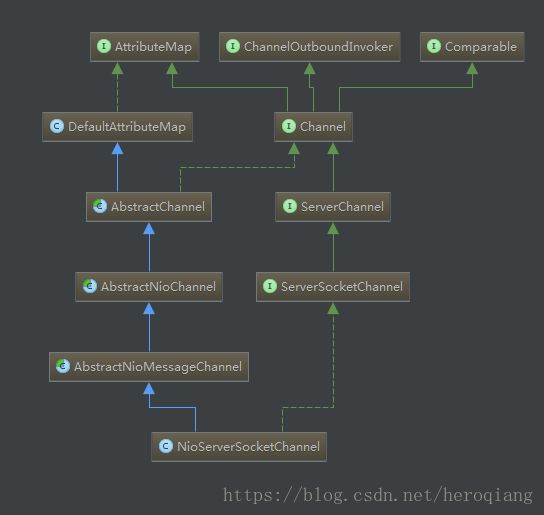Netty源码解析之ServerSocketChannel bind流程
阅读须知
- Netty版本:4.1.14.Final
- 文章中使用/* */注释的方法会做深入分析
正文
提起Channel,相信熟悉java网络编程的同学都不陌生,Channel是JDK NIO类库的重要组成部分,用于非阻塞的I/O操作,同样的,Netty也提供了自己的Channel实现,为什么Netty不使用JDK NIO原生的Channel而要自己实现新的Channel呢?我们引用《Netty权威指南》这本书中对这个问题的解答:
- JDK的SocketChannel和ServerSocketChannel没有统一的Channel接口供业务开发者使用,对于用户而言,没有统一的操作视图,使用起来并不方便。
- JDK的SocketChannel和ServerSocketChannel和主要职责就是网络I/O操作,由于他们是SPI接口,由具体的虚拟机厂家提供,所以通过集成SPI功能类来扩展其功能的难度很大,直接实现ServerSocketChannel和SocketChannel抽象类,其工作量和重新开发一个新的Channel功能类是差不多的。
- Netty的Channel需要能够跟Netty的整体架构融合在一起,例如I/O模型、基于ChannelPipeline的定制模型,以及基于元数据描述配置化的TCP参数等,这些JDK的SocketChannel和ServerSocketChannel都没有提供,需要重新封装。
- 自定义的Channel,功能实现更加灵活。
基于上述4个原因,Netty重新设计了Channel接口,并且给予了很多不同的实现。它的设计原理比较简单,但是功能却比较繁杂,主要的设计理念如下:
- 在Channel接口层,采用Facade模式进行统一封装,将网络I/O操作、网络I/O相关联的其他操作封装起来,统一对外提供。
- Channel接口的定义尽量大而全,为SocketChannel和ServerSocketChannel提供统一视图,由不同子类实现不同的功能,公共功能在抽象父类中实现,最大程度上实现功能和接口的重用。
- 具体实现采用聚和而非包含的方式,将相关的功能类聚和在Channel中,由Channel统一负责分配和调度,功能实现更加灵活。
Channel是与网络socket或能够进行I / O操作(如读取,写入,连接和绑定)的组件的纽带。
Channel的功能比较繁杂,我们在ServerBootstrap源码分析文章的开篇部分写了一个小的启动demo,demo中使用了NioServerSocketChannel,我们就以NioServerSocketChannel作为入口进行分析,首先我们来看NioServerSocketChannel的层次结构图:

构造函数:
public NioServerSocketChannel() {
this(newSocket(DEFAULT_SELECTOR_PROVIDER));
}
这里的newSocket方法会返回JDK的ServerSocketChannel实例,实现为ServerSocketChannelImpl。
NioServerSocketChannel:
public NioServerSocketChannel(ServerSocketChannel channel) {
super(null, channel, SelectionKey.OP_ACCEPT);
config = new NioServerSocketChannelConfig(this, javaChannel().socket());
}
这里的javaChannel().socket()会调用JDK的ServerSocketChannelImpl的socket方法返回JDK的ServerSocket实例。
AbstractNioMessageChannel:
protected AbstractNioMessageChannel(Channel parent, SelectableChannel ch, int readInterestOp) {
super(parent, ch, readInterestOp);
}
AbstractNioChannel:
protected AbstractNioChannel(Channel parent, SelectableChannel ch, int readInterestOp) {
super(parent);
this.ch = ch;
this.readInterestOp = readInterestOp;
try {
ch.configureBlocking(false);
} catch (IOException e) {
try {
ch.close();
} catch (IOException e2) {
if (logger.isWarnEnabled()) {
logger.warn(
"Failed to close a partially initialized socket.", e2);
}
}
throw new ChannelException("Failed to enter non-blocking mode.", e);
}
}
AbstractChannel:
protected AbstractChannel(Channel parent) {
this.parent = parent;
id = newId();
unsafe = newUnsafe(); // NioMessageUnsafe
pipeline = newChannelPipeline(); // DefaultChannelPipeline
}
我们在分析ServerBootstrap源码时看到了启动过程中对channel.bind方法的调用,我们来分析一下bind方法的实现:
AbstractChannel:
public ChannelFuture bind(SocketAddress localAddress, ChannelPromise promise) {
return pipeline.bind(localAddress, promise);
}
这里的pipeline也就是我们刚刚看到的在构造函数中初始化的DefaultChannelPipeline。
public final ChannelFuture bind(SocketAddress localAddress, ChannelPromise promise) {
return tail.bind(localAddress, promise);
}
这里的tail对象是一个ChannelHandlerContext接口的实例,它的作用是作为ChannelHandler和ChannelPipeline交互的上下文。
AbstractChannelHandlerContext:
public ChannelFuture bind(final SocketAddress localAddress, final ChannelPromise promise) {
if (localAddress == null) {
throw new NullPointerException("localAddress");
}
if (isNotValidPromise(promise, false)) {
return promise; // 如果promise不合法,取消
}
// 这里会取出第一个outbound为true的ChannelHandlerContext,初始化pipeline时初始化了两个ChannelHandlerContext
// tail和head,tail的outbound属性赋值为false,head的outbound属性赋值为true,所以这里首次取出的是head
final AbstractChannelHandlerContext next = findContextOutbound();
// 获取线程组,这里获取到的是boss线程组
EventExecutor executor = next.executor();
// 判断当前线程是否正在事件循环中执行
if (executor.inEventLoop()) {
/* 绑定调用 */
next.invokeBind(localAddress, promise);
} else {
safeExecute(executor, new Runnable() {
@Override
public void run() {
/* 绑定调用 */
next.invokeBind(localAddress, promise);
}
}, promise, null);
}
return promise;
}
AbstractChannelHandlerContext:
private void invokeBind(SocketAddress localAddress, ChannelPromise promise) {
// 尽可能判断是否调用了ChannelHandler的handlerAdded方法
// handlerAdded方法会在将ChannelHandler添加到上下文并准备好处理事件之后调用
if (invokeHandler()) {
try {
/* 绑定 */
((ChannelOutboundHandler) handler()).bind(this, localAddress, promise);
} catch (Throwable t) {
// 失败通知监听器
notifyOutboundHandlerException(t, promise);
}
} else {
bind(localAddress, promise); // 递归
}
}
DefaultChannelPipeline.HeadContext:
public void bind(ChannelHandlerContext ctx, SocketAddress localAddress, ChannelPromise promise)
throws Exception {
unsafe.bind(localAddress, promise);
}
这里的unsafe来自于channel的unsafe。示例中我们使用的NioServerSocketChannel的unsafe为NioMessageUnsafe实例。
AbstractChannel.AbstractUnsafe:
public final void bind(final SocketAddress localAddress, final ChannelPromise promise) {
// 断言Channel未注册并且当前线程正在事件循环中执行
assertEventLoop();
if (!promise.setUncancellable() || !ensureOpen(promise)) {
return;
}
if (Boolean.TRUE.equals(config().getOption(ChannelOption.SO_BROADCAST)) &&
localAddress instanceof InetSocketAddress &&
!((InetSocketAddress) localAddress).getAddress().isAnyLocalAddress() &&
!PlatformDependent.isWindows() && !PlatformDependent.maybeSuperUser()) {
logger.warn(
"A non-root user can't receive a broadcast packet if the socket " +
"is not bound to a wildcard address; binding to a non-wildcard " +
"address (" + localAddress + ") anyway as requested.");
}
// 判断Channel的活跃状态,示例中使用的NioServerSocketChannel调用的是JDK的ServerSocket的isBound方法判断绑定状态
boolean wasActive = isActive();
try {
/* 绑定操作 */
doBind(localAddress);
} catch (Throwable t) {
// 异常将指定的promise标记为失败
safeSetFailure(promise, t);
// 如果Channel未开启,则关闭Channel
closeIfClosed();
return;
}
// 判断Channel是否是在绑定后变为活跃状态
if (!wasActive && isActive()) {
invokeLater(new Runnable() {
@Override
public void run() {
// Channel激活,调用ChannelInboundHandler的channelActive方法
pipeline.fireChannelActive();
}
});
}
// 将指定的promise标记为成功
safeSetSuccess(promise);
}
Channel关闭流程详见:Netty源码解析之ServerSocketChannel close流程,关于promise的操作我们会在Promise源码分析的文章中进行详细分析,示例中我们使用的是NioServerSocketChannel,我们来看NioServerSocketChannel对doBind方法的实现:
protected void doBind(SocketAddress localAddress) throws Exception {
if (PlatformDependent.javaVersion() >= 7) {
javaChannel().bind(localAddress, config.getBacklog());
} else {
javaChannel().socket().bind(localAddress, config.getBacklog());
}
}
这里就是调用JDK原生的函数来实现绑定操作,java7以上的版本调用我们上文提到的ServerSocketChannelImpl的bind方法实现,java7以下的版本调用ServerSocket的bind方法实现,bind操作会将channel的socket绑定到本地地址,并配置socket以侦听连接。到这里,bind流程的源码分析就完成了。